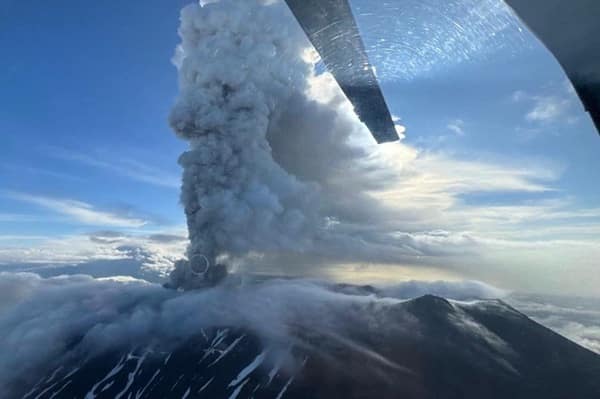The Krasheninnikov Volcano in eastern Russia has erupted for the first time in 600 years sending an ash cloud 32,800 ft into the sky.
This comes after an 8.8 magnitude earthquake hit in eastern Russia causing a tsunami in the Pacific which triggered the Kamchatka volcano.
Last week Russian state news agency RIA reported that the Klyuchevskoy, one of the world’s highest volcanoes, and the Russian Academy of Sciences has confirmed it has erupted several times over the years.
The academy has said that lava can be seen flowing down the western side of the mountain.
They wrote on Telegram last week, “A descent of burning hot lava is observed on the western slope. Powerful glow above the volcano, explosions.”
Vsevolod Yakovlev, head of the Kronotsky Nature Reserve, said on Sunday, “Its eruption is not something out of the ordinary for a region with high volcanic activity.
“During satellite monitoring, thermal spots have been repeatedly noted in the area of the Krasheninnikov volcano.
🌋 ** WOW. Eurasia’s Largest Volcano Erupts After 8.7 Earthquake in Russia **
💥 FIRST recorded eruption since 1550 (460+ years)
Krasheninnikov’s ash cloud now 5–6KM high pic.twitter.com/wlRhuQiIMX
— Lenka White (@white_lenka) August 2, 2025
“This is a significant increase in temperature on the Earth’s surface compared to neighbouring areas.”
RIA state news agency today, Olga Girina, chief of the Kamchatka Volcanic Eruption Response Team, confirmed the historic event: “This is the first historically confirmed eruption of Krasheninnikov Volcano in 600 years.
Russian volcanologist Alexei Ozerov said, “A crack opened up along the volcano from the top of the crater, and a steam-gas mixture is currently rising from this crack.
“Emissions are occurring, and a large amount of ash was ejected during the opening of the crater crack.
“This ash reached the Valley of Geysers, and …the smell of gas…
“A question is immediately raised about the evacuation of the Valley of Geysers, those tourists who are there.”
A Russian response team said, “The explosive eruption of the volcano continues.
“Ash explosions up to 10 km (32,800 ft) above sea level could occur at any time.
“Ongoing activity could affect international and low-flying aircraft.”








